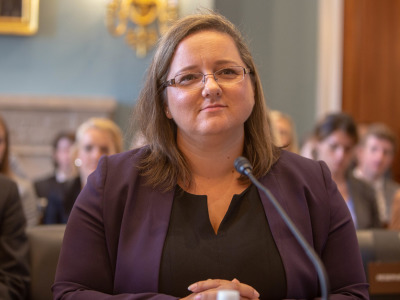Agriculture groups, private industries, and federal and state legislators are driving soil health initiatives across the country, helping farmers and ranchers overcome obstacles in a win/win for producers and the environment.
“Soil health is a critical topic for this Subcommittee to address because it underpins so many of our other conservation efforts,” said Rep. Abigail Spanberger, the Virginia Democrat who chairs the House Agriculture Committee’s conservation subcommittee, during a hearing Tuesday.
“Soil health practices such as cover crops, crop rotations, and no-till or reduced-tillage have the potential to provide financial benefits to farmers by reducing input costs, increasing yields, and ensuring the productivity of crop land over the long term.”
Subcommittee ranking member Doug LaMalfa, R-Calif., echoed her sentiment, saying improving soil health "can help optimize inputs, increase resiliency and improve yields, regardless of weather patterns” on a farmers’ operations.
Soil health is measured by the amount of biological activity in the soil and the soil’s ability to hold water. The more organic matter a soil has, the more biological activity occurs in the soil allowing the soil to retain a higher water holding capacity.
In an interview with Agri-Pulse separate from the subcommittee hearing, Duane Hovorka, agriculture program director at the Izaak Walton League of America said soil health plans should “encourage and feed the beneficial bacteria and fungi” in the soil because current practices are “starving the microbes” in the ground. Reducing tillage and excess pesticide use, he said, would lead to more carbon and organic matter in the soil, “which makes that biology much more healthy in the soil.”
For example, a soil that has 1% of organic matter may hold less than one inch of rain. Once the soil meets its maximum holding capacity, the ground will become saturated. This leads to water running off a field, carrying nutrients and other fine particles away and causing nutrient runoff and the displacement of top soil. It can also carry manure and other chemicals that have not been absorbed by the plants into the water system. If that same soil had 5% organic matter, it may hold up to three and a half inches of rain, increasing the water holding capacity.
Wayne Honeycutt, president and CEO of the Soil Health Institute, shared with Agri-Pulse how the Institute is working to help land managers “look at themselves as not just crop producers but as carbon managers.” That way, when producers are making their management decisions they also base that decision “on the impact that it’s going to have on carbon.”
Hovorka and witnesses testifying at the hearing identified five key practices stated to promote soil health: no-till farming; planting cover crops; diversifying and rotating plants; implementing integrated pest management practices; and adding livestock back on the land for grazing.
“How fast the change happens [seeing a return on your investment] depends on how many of those practices you implement and how you put them together,” said Hovorka.
Speaking to the subcommittee, Shefali Mehta, executive director of the Soil Health Partnership said the partnership's goal “is to meet the need of our farmers and continue to add more tools to their tool kit to ensure they have more economic diversification.”
Both Hovorka and Mehta said these practices “are in no way a silver bullet” and must be adopted according to the goals of the farmer and in accordance with what works best in certain parts of the country. Adopting these practices are not as easy as it may seem when you consider potentially higher input costs, equipment changes, and changing attitudes about soil health, they pointed out.
USDA has numerous resources that can assist with improving soil health, starting with a test kit guide.
IWLA’s Hovorka said government funds should go towards transition not maintenance.
“We don’t see the need to pay farmers forever to plant cover crops, even though they are delivering a lot of public benefits,” Hovorka added. “We think that structuring our incentives as transition incentives will help get people into an economic way of farming.”
The IWLA recently published a report that highlights different local and state soil health initiatives that are already in place or close to be.
“We wanted to highlight the different kinds of proposals," Havorka said. "Some states are taking a statewide approach like California and some places are focused more on providing incentives for specific practices. That is what they are doing in Iowa with a discount on your federal crop insurance for farmers who plant cover crops."
Among the state initiatives detailed in the report was the California Healthy Soils Initiative. That initiative, launched in 2015, is in collaboration with seven state agencies and departments and promotes the stewardship of healthy soils. In 2016, the state legislature created and funded the Healthy Soils Program, which provides producer incentives to producer to adopt greenhouse-gas-reducing soil health practices such as: compost and mulch application, cover cropping, reduced tillage, planting windbreaks, riparian buffers and hedgerows, and the implementation of silvopasture, an integrated intensively managed system that combines trees, forage plants, and livestock together.

Shannon Douglass, California Farm Bureau
Shannon Douglass, 1st Vice President of the California Farm Bureau Federation, told the subcommittee CFBF has outlined three principles on soil health that legislators should consider when looking at soil health practices: Flexibility and the need "to ensure soil health practices and growers are not one size fits all," a point she emphasized by pointing out California's 400 commodities grown within its borders; Continued research and the discovery of “new technologies that have the potential to improve soil health;”
Legislators also need to take into consideration, “other on-farm practices" such as those required by the Food Safety Modernization Act and be thoughtful of the “intersection of practices required by law to ensure the best practices under NRCS are not harming the food safety and other regulations,” she said.
Here are three other state examples highlighted in the report:
The Maryland Healthy Soils Initiative, first proposed in 2016 and designed to improve health, yield, and profitability of soils while also increasing carbon sequestration. It includes education, technical assistance and financial incentives to implement farm management practices that contribute to healthy soils. In 2018, legislators included the Greenhouse Gas Reduction Act Plan geared toward helping Maryland reach 40% reduction by 2030.
The Iowa Soil Health Monitoring program was designed to collect data on soil health parameters. It is overseen by the state Department of Agriculture in partnership with Iowa State University. Every two years, the two entities produce a report to the legislature with recommendations to sustain and improve soil resources and propose legislation or rule changes.
Coordinated by Cornell University, the New York Soil Health Roadmap identifies key policy, research and education efforts to overcome barriers to adopt soil health practices by farmers, while also identifying strategies for integrated soil health goals with state priorities focused on environmental issues such as climate change and water quality.
This story has been updated to clarify that comments from Duane Hovorka and Wayne Honeycutt were in conversations with Agri-Pulse, not offered in testimony to a House Agriculture subcommittee.
For more news, go to www.Agri-Pulse.com.


